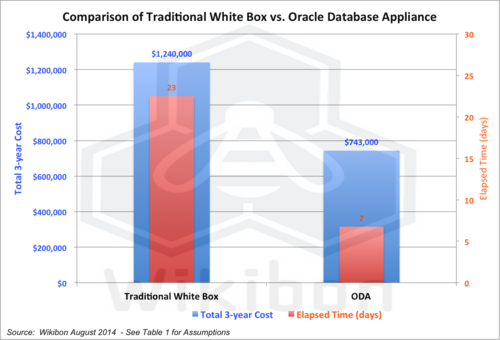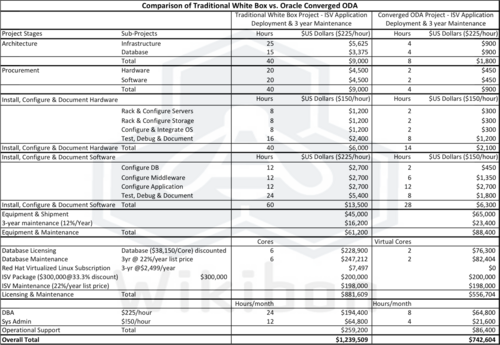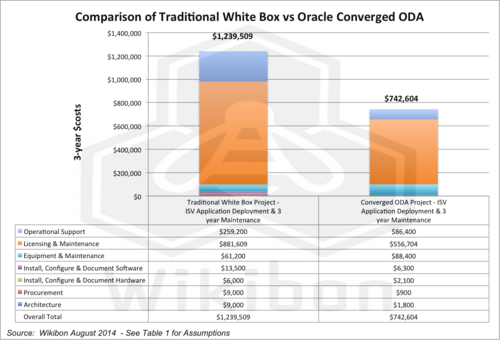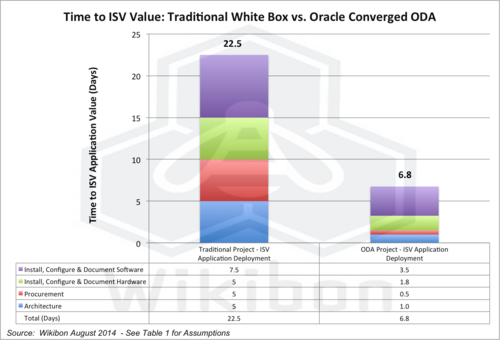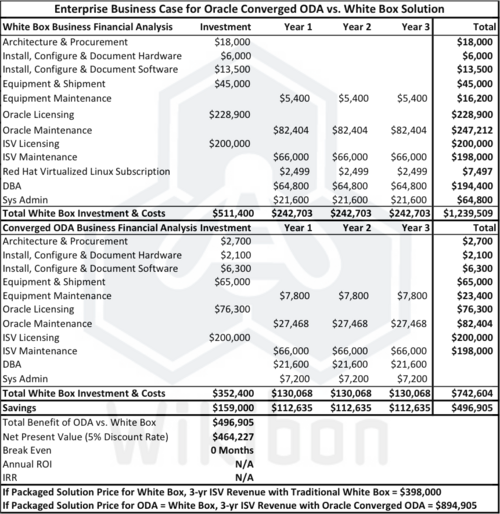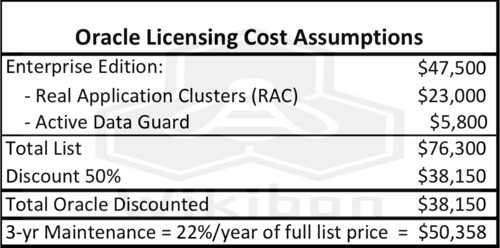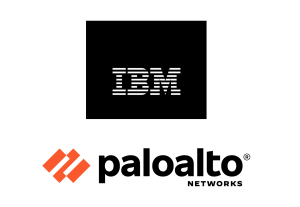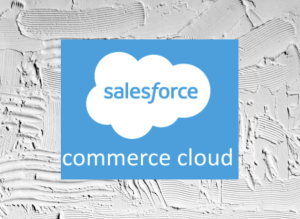Executive Summary
Wikibon has focused significant research on the value of creating Single Managed Entities (SMEs) for reducing operational costs and duplicating public cloud economics for Oracle database infrastructure. Figure 1 shows the principle of reducing the number of elements in a converged infrastructure stack (ideally to 1) and reducing the cost of deployment and maintenance, as well as reducing the time-to-value of software implementations and upgrades.
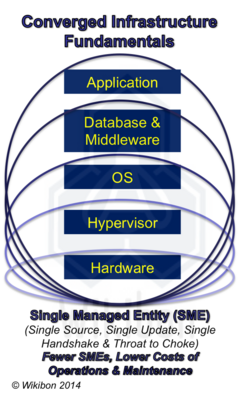
Recently Wikibon spoke in depth with three ISVs ⎼ Re-Quest, Temenos, and Mformation ⎼ about the use of the Oracle Database Appliance. From these interviews and other research, Wikibon developed a general financial model which quantifies the benefit of Oracle Database Appliance for ISVs, integrators and their customers. Figure 2 shows the executive summary results. The detailed results are in Table 1 and Figures 3 & 4 below.
Converged appliances create value by reducing the complexity and risk in development, deployment, and support for ISVs and their customers compared with the traditional “best-of-breed” white-box approach. In addition to licensing cost reductions, solutions built on top of converged appliances require fewer integration points and reduce the number of unique problems that complicate support for vendors and users.
Easier scaling means greater flexibility with less complexity. It improves staff utilization, since they have fewer unique problems to handle. This allows staff to focus on a narrower set of skills better tuned to the needs of the business. For solution users, faster first-time and update deployment means faster time-to-value.
Wikibon believes that the strategic business case for Oracle Database Appliance and other single SME converged appliances is overwhelming for ISVs, integrators, and their customers and will be an essential method for ISVs and integrators to deliver solutions on-site with a cost structure competitive to application-as-a-service (AaaS) cloud providers.
Oracle Database Appliance Value Proposition For ISVs And Integrators
ISVs and integrators using database appliances experience value based on better margins, faster time to market and improved customer service and support. The appliance-based solution is effectively off-the-shelf from hardware through software, making regression testing more efficient, so solution ISVs can deliver new products and features to market faster. Moreover, the reduction in complexity means that the offering is ready for customer acceptance faster. Fewer integration points and interfaces decrease the cost of application development and maintenance.
Hardware and software environment standardization means fewer customer support calls (especially unique ones), so the organization needs less staff to handle them. If you’ve seen the ticket before, it’s much easier to resolve compared with the burden of dealing with “never seen before” issues. In addition, standardization enables more seamless scaling than alternative approaches since many fewer unique configurations are in the inventory.
A database appliance can enable better staff utilization because the required skill sets are narrower, eliminating the need for a “deep bench” of practitioners covering a wide variety of environments. Deployment time for an appliance is much faster for the vendor than creating one-off solutions. In addition, the appliance approach affords the vendor the opportunity to templatize vs. creating unique patches. As a result, the vendor can deliver patches that are pre-integrated and pretested.
In terms of customer service, a database appliance-based offering allows the vendor to create a Single Managed Entity (SME) relationship with a client, offering packaged hardware, software and support with increased responsiveness and control over the deployment and its updates.
Oracle Database Appliance Value Proposition For Customers
Users of database appliance-based solutions experience complementary value based on lower initial costs, faster solution deployment, higher solution reliability, and lower support and upgrade costs. To begin with, a database appliance-based solution can assist users to license only the Oracle database software that is needed. Deployment costs are lower and speed to deploy faster. If you’re charging $1,000/day per person for 10 people for six months to get a solution live, cutting that to a few weeks creates more than $200,000 hard dollar savings for the customer. Better maintenance and support via “dial home” options and faster time to solution can be more valuable than lower infrastructure cost itself.
Lastly, simplicity is key. The last thing a solution user may want to do is worry about every nickel’s worth of parameters around an Oracle RAC implementation. Deploying a standard RAC implementation is much cheaper and quicker for customers (fewer DBAs and admins), with greater flexibility to scale requirements rapidly and seamlessly.
Integrator: Re-Quest
Re-Quest Inc., originally founded in 1991, is an early adopter of Oracle’s Database Appliance technology. It is an integrator and Platinum Specialized Database Partner with Oracle’s Partner Network, as well as a Verified Pillar Partner for the Database Platform & Grid product. Re-Quest assists customers globally to leverage their investment in technology assets to gain higher returns on investment, lower total cost of ownership, and measurable improvement in their business processes. Re-Quest believes in the concept of disruptive technologies and in that spirit became one of the early adopters of Oracle Database Appliance. It is currently considered one of Oracle’s Strategic partners for delivering solutions on the appliance.
In assessing its value, Re-Quest believes that fewer integration points and interfaces equals better value vs. a “best-of-breed” platform component approach. In its view, best-of-breed typically winds up as a one-off versus a pre-integrated and pre-tested solution. It sees the database appliance approach as simpler to implement, manage, and support. In its view, if the application does the job, the real TCO value comes in avoidance of support costs and fewer risks.
Re-Quest’s experience is that infrastructure simplicity is key and that advanced Oracle users actually grasp the value of simplicity better than most. For instance, while the variety of RAC offerings provides the customer with a lot of functionality, this can also make it more difficult and costly to deploy it optimally within the application. Re-Quest has reduced the speed to deploy RAC on Oracle Database Appliance by seven times versus a white box server approach. Re-Quest observes that more variables in the environment means more support issues – especially those that are one-of-a-kind. Standardization means fewer calls overall, fewer unique calls in particular and therefore a smaller support staff. Re-Quest reports that this approach has led to 20%-40% fewer one-off calls from customers.
Re-Quest sees converged infrastructure as a disruptive technology that is capturing significant interest. Initially, Re-Quest customers were wary of an Oracle Database Appliance and having Oracle own both the software and hardware. But in their experience, users are beginning to ask for a database appliance approach to their solution.
ISV: Temenos
Temenos was founded in 1993 in Geneva to enable the banking industry to move off its legacy software base. Temenos has more than 1,600 installations in more than 150 countries and has invested more than $1B growing its product set from just core banking to include payments, wealth management, business analytics, and channels. It has developed a large network of partners to enable Temenos to scale delivery of its solutions to banks of all sizes globally.
For Temenos, the value of a database appliance is a reduction in complexity, which accelerates its time-to-market for new solutions and upgrades. This enables Temenos’ customers to experience better system resilience, 30%-40% less time-to-deployment of their business processes, and lower overhead and maintenance with, for example, a 30% reduction in DBA labor. It sees the “all-in-one-box” as being very appealing for their banking customers – especially in parts of the world where less Oracle support is available.
Temenos reports reducing set-up costs by three-to-four weeks by avoiding having to install and cable different servers. The Temenos solution on the database appliance is effectively pre-tested. So the speed at which Tenemos can deploy the application and the probability of customer acceptance is extremely high. Using its model bank technology, Temenos solutions can be deployed and in use in a matter of a few months vs. the more typical banking solutions deployment cycle of closer to a year. Speed to deploy for the customer also equates to savings on consultant headcount and days in the field, resulting in significant hard dollar savings.
Temenos believes it is possible to approach the level of performance achievable with an ODA converged infrastructure platform. However, these alternatives aren’t true all-in-one solutions and would be much more costly – a few $100K vs. <$100K.
ISV: Mformation
Mformation, founded in 1999, is a leader in mobility management solutions and plays a vital enabling role in defining industry standards for both mobile operators and device manufacturers. Its scalable software solutions help network operators seamlessly manage an ever-changing array of mobile technologies. These range from the latest smartphones, tablets and M2M devices to the host of mobile apps, services, and content that fuel traditional voice and data revenue streams, as well as evolving services for the “Internet-of-things.”
Mformation’s numerous patents and technical leadership in core mobility management technologies are the foundation for dynamic software that supports mission-critical OSS and BSS operations. Mformation recognized the Oracle Database Appliance as a unique platform that simplifies the solution architecture into a single box; it is strongly recommended to their customers. While Mformation software is also deployed on Linux and Unix systems, the Oracle Database Appliance simplifies customer deployments by eliminating the need for multiple platforms and configurations.
Mformation software supports automated management of FOTA and SCOMO transactions for global tier 1 operators and is rapidly growing to support billions of devices in the “Internet-of-things”. When scalability for dynamic handling of transactions is critical, Mformation turns to the Oracle Database Appliance for efficiently delivering system resources. When an operator wants to increase the frequency of mobile phone updates, for instance, the Mformation system has to be able to scale rapidly to handle an immediate 2X or greater increase in volume and velocity of transactions and updates. Mformation’s unique position managing cellular and non-cellular machine-to-machine devices requires even greater scale and extraordinary availability.
Business Case For An ODA Appliance
Wikibon defined the main project stages and cost elements in deploying an ISV or integrator solution as:
- Architecture;
- Procurement;
- Installing, configuring and document the hardware;
- Installing, configuring and document the software;
- Equipment maintenance;
- Licensing & maintenance of database, infrastructure software & ISV software;
- Operational support.
Table 1 compares the costs and elapsed time of a traditional best-of-breed white box approach to a fully integrated solution based on the Oracle Database Appliance. The assessments were based on the three case studies along with other ODA data and general data from other converged infrastructure platforms. The benefits come from lower implementation costs and faster time to solution.
Figure 3 presents the cost differences from Table 1. The typical cost of a traditional model is estimated as $1.2 million, 67% more expensive than the ODA approach, estimated as $0.7 million. A significant chunk of the savings comes from lower Oracle licensing costs with ODA. This is because Oracle used the virtual cores allocated to running the database as the basis for charging in the ODA. For traditional solutions the total cores in the white box would be used as the basis for establishing Oracle license costs.
Figure 4 presents the elapsed time differences from Table 1. The typical overall elapsed time with a traditional model is estimated as 22.5 days, 223% greater than the ODA approach estimation of 6.8 days.
Conclusions
The business case for using ODA is shown in Table 2 above, based on the data in Table 1 above and in Tables 3 & 4 in the footnotes below.
One disadvantage of ODA is the same as its advantage. “One throat to choke” implies one vendor with the potential for lock-in. Another disadvantage is that the hardware cannot cost effectively be used for other databases. The vertical scaling of the ODA servers and storage is limited, which means it cannot cover all the potential use cases for some ISV providers. However, from an ISV’s customer perspective, the choice of ODA is an absolute no-brainer. The costs are always lower, and the elapsed time for deployment is one-third.
It is interesting to look at the last two sentences in Figure 2. All software vendors sell the value of their solution as reducing organizational costs and increasing revenue (if appropriate) and customer satisfaction. The overall cost of implementation in the traditional model is $1.2 million, and the ISV receives revenue of $398,000. The ISV can deliver higher value by installing the solution 16 days earlier with less risk. If the ISV value packaged the ODA solution at the same price as the traditional solution ($1.2million), the ISV would receive revenues of $895,000, an additional $0.5 million in revenue – with the additional value of faster implementation. By completely packaging the ODA hardware and ISV software as a bundle, ISVs can significantly increase net revenue from engagements.
Action Item: This study and other Wikibon work shows very clearly that ISVs should deliver their software and solutions using converged infrastructure where possible. The reduction in business costs to the ISV from lower testing, deployment and maintenance costs enable either lower solution costs and increased value, or higher and more profitable value-based revenues. Because of the additional integration of the Oracle hardware and database software, and the virtual licensing costs of the Oracle database, the Oracle Database Appliance is very likely to be the lowest cost solution, giving the fastest time-to-value. When the ODA fits the performance requirements of an application, Wikibon recommends all software makers and distributors using an Oracle database should always include Oracle’s ODA on the RFP and evaluate the sole use of ODA as a major cost-saving and value creation initiative.
Footnotes:

